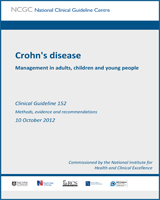10.4.1. Clinical introduction
The concept that early detection of a relapse in Crohn's disease would lead to earlier treatment and therefore less severe and destructive disease is the basis for much of the long-term management of this condition. It appeals to both patient and clinician. It introduces the hope that effective treatment could alter the natural course of Crohn's disease. With this in mind there has been an ongoing search for indicators of an impending relapse. These have varied from a patient's own assessment of how they feel through to sophisticated monitoring of a range of inflammatory markers.
In order for such an approach to be effective it is essential that the marker changes significantly ahead of clinical deterioration. In other words changes in such markers need to be predictors of a clinical relapse rather than the consequence of it. For routine monitoring to be worthwhile these changes need to precede clinical deterioration by months rather than weeks. In addition there needs to be a clear level at which an abnormality is an effective predictor of disease relapse and there should not be significant overlap with levels that can be recorded during remission. Finally if such predictors of relapse can be identified they need to be of clinical value -they need to lead to interventions which can be shown objectively through randomised controlled trials to prevent or shorten disease relapse and to be reflected in a better quality of life for patients.
10.4.2. Clinical questions
Does predicting early relapse through monitoring
compared with standard care, improve patient outcomes (quality of life, future surgery, hospitalization)?
10.4.3. Clinical evidence
There were no Cochrane reviews or RCTs identified for this prognostic review. A systematic review of the literature identified 11 cohort studies which met the inclusion criteria for this . There were no studies which addressed the use of unintended weight loss, MRI, colonoscopy, endoscopy or growth in children for prediction of early relapse. Studies utilising faecal calprotectin (FC), CRP and ESR in adults27,32,44,59,97,103,142,149,281,306 and children297 for prediction of early relapse were reviewed. These studies were prognositic in design and assessed asymptomatic patients who were then followed to relapse.
Faecal calprotectin, CRP and ESR as predictors of early relapse – evidence profile.
The normal ranges for faecal calprotectin, erythrocyte sedimentation rate (ESR) and C-reactive protein (CRP) are presented below. Measurement methods for faecal calprotectin in the included studies varied and all values are subject to laboratory specific variations.
View in own window
| Faecal calprotectin μg/g | |
|---|
| Ages 2-9 years | < 166 |
| Ages 10-59 years | < 51 |
| Ages ≥ 60 | < 112 |
| |
| Faecal calprotectin mg/kg | |
|---|
| Upper limit of normal | < 50 |
| |
| Faecal calprotectin mg/L | |
|---|
| Upper limit of normal | < 10 |
| |
| CRP mg/L | |
|---|
| Low risk IBD relapse (Normal) | < 10 |
| Average risk IBD relapse | 10 to 30 |
| High risk IBD relapse | > 30 |
View in own window
| ESR mm/hour (upper limit of normal) |
|---|
| Ages | 20 | 55 | 90 years |
|---|
| Men | 12 | 14 | 19 |
| Women | 18 | 21 | 23 |
| Neonatal to puberty | 3 to 13 | | |
For this prognostic review, time to event data, with multivariate analysis was extracted if possible. Cut-off values determined by ROC curves constructed to predict risk in individual studies are presented.
In this review the prognostic factor is a dichotomous variable and the outcome is time-to-event/dichotomous. The results (OR/RR/HR) describe the effect on the outcome of the presence compared with the absence of the prognostic factor. Presence versus absence means above versus below the threshold. The forest plots presented in Appendix G: show that when the odds ratio, relative risk or hazard ratio is greater than 1, values above the threshold predict relapse, and when below 1, values above the threshold predict protection against relapse.
10.4.3.1. Evidence statements - clinical
In a summary of five studies (n = 327)
97,103,142,281,297 faecal calprotectin appears to be effective for assessing risk of
relapse in Crohn's disease. One study (n = 65)
59 showed no effect. Each study used different thresholds for prediction of relapse.[LOW QUALITY]
In one study (n = 65)
59 CRP appears to be effective for assessing risk of
relapse in Crohn's disease. A summary of three studies (n = 225)
27,44,142 showed no effect. Each study used different thresholds for prediction of relapse.[LOW QUALITY]
In one study (n = 71)
44 ESR appears to be effective for assessing risk of
relapse in Crohn's disease. One study (n = 65)
59 showed no effect. Each study used different thresholds for prediction of relapse.[LOW QUALITY]


